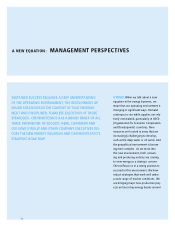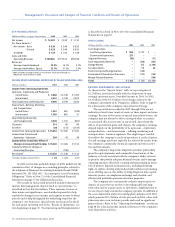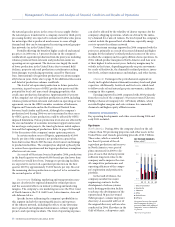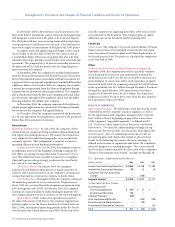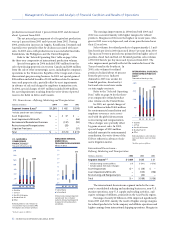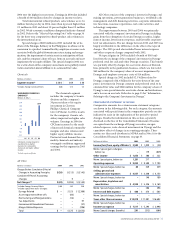Chevron 2004 Annual Report Download - page 26
Download and view the complete annual report
Please find page 26 of the 2004 Chevron annual report below. You can navigate through the pages in the report by either clicking on the pages listed below, or by using the keyword search tool below to find specific information within the annual report.
GLOSSARY OF ENERGY AND FINANCIAL TERMS
Chemicals to control engine deposits
and improve lubricating performance.
(BOE) A unit of
measure to quantify crude oil and natural gas
amounts using the same basis. Natural gas
volumes are converted to barrels on the basis
of energy content. See oil-equivalent gas and
production.
Liquid hydrocarbons produced
with natural gas, separated by cooling and
other means.
Techniques used to
increase or prolong production from crude
oil and natural gas fields.
Searching for crude oil and/or natu-
ral gas by utilizing geologic and topographical
studies, geophysical and seismic surveys, and
drilling of wells.
(GTL) A process that converts
natural gas into high-quality transportation fuels.
Gases that trap heat in
the Earth’s atmosphere (e.g., carbon dioxide,
methane, nitrous oxide, hydrofluorocarbons,
perfluorocarbons and sulfur hexafluoride).
A company
engaged in all aspects of the energy industry:
exploring for and producing crude oil and
natural gas (upstream); refining, marketing
and transporting crude oil, natural gas and
refined products (downstream); manufacturing
and distributing petrochemicals (chemicals);
and generating power.
(LNG) Natural gas that
is liquefied under extremely cold temperatures
to facilitate storage or transportation in spe-
cially designed vessels.
(LPG) Light gases,
such as butane and propane, that can be main-
tained as liquids while under pressure.
(NGL) Separated from natu-
ral gas, these include ethane, propane, butane
and natural gasoline.
(OEG) The volume of natural
gas needed to generate the equivalent amount
of heat as a barrel of crude oil. Approximately
6,000 cubic feet of natural gas is equivalent to
one barrel of crude oil.
Naturally occurring mixture of
bitumen – a heavy, viscous form of crude oil –
water, sand and clay. Using hydroprocessing
technology, bitumen can be refined to yield
synthetic crude oils.
Derived from petroleum; used
principally for the manufacture of chemicals,
plastics and resins, synthetic fibers, deter-
gents, adhesives, and synthetic motor oils.
Total production refers to all the
crude oil and natural gas produced from a
property. Gross production is the company’s
share of total production before deducting roy-
alties. Net production is gross production minus
royalties paid to landowners. Oil-equivalent
production is the sum of the barrels of liquids
and the oil-equivalent barrels of natural gas
produced. See barrels of oil-equivalent and oil-
equivalent gas.
Represents average
crude oil consumed in fuel and asphalt refiner-
ies for the year expressed as a percentage of
the refineries’ average annual crude unit capac-
ity adjusted for refinery dispositions.
Energy resources that are not
depleted when consumed or converted into
other forms of energy (e.g., solar, geothermal,
ocean and tide, wind, hydroelectric power,
biomass fuels, and hydrogen).
Crude oil or natural gas contained
in underground rock formations called res-
ervoirs. Proved reserves are the estimated
quantities that geologic and engineering data
demonstrate can be produced with reasonable
certainty from known reservoirs under existing
economic and operating conditions. Estimates
change as additional information becomes
available. Oil-equivalent reserves are the sum of
the liquids reserves and the oil-equivalent gas
reserves. See barrels of oil-equivalent and oil-
equivalent gas.
The rules of the United States Securities
and Exchange Commission (SEC) permit oil
and gas companies to disclose in their filings
with the SEC only proved reserves. Certain
terms, such as “probable” or “possible”
reserves, “potentially recoverable” volumes,
or “resources,” among others, may be used to
describe certain oil and gas properties in sec-
tions of this document that are not filed with
the SEC. We use these other terms, which are
not approved for use in SEC filings, because
they are commonly used in the industry, are
measures considered by management to be
important in making capital investment and
operating decisions, and provide some indi-
cation to our stockholders of the potential
ultimate recovery of oil and gas from properties
in which we have an interest. In that regard,
potentially recoverable volumes are those that
can be produced using all known primary and
enhanced recovery methods.
A marketable and trans-
portable hydrocarbon liquid, resembling crude
oil, that is produced by upgrading highly vis-
cous to solid hydrocarbons, such as extra-heavy
crude oil or oil sands.
Cash
generated from the company’s businesses, an
indicator of a company’s ability to pay divi-
dends and fund capital programs. Excludes
cash flows related to the company’s financing
and investing activities.
The effect on net income in the
period of change of a retroactive calculation
and application of a new accounting principle.
The difference between the cost of pur-
chasing, producing and/or marketing a product
and its sales price.
The incremental
expenses incurred to effect the combination
of Chevron and Texaco. The amount shown
on the Income Statement is before income tax.
Examples are employee termination expenses;
professional service fees for investment bank-
ers, attorneys and public accountants; employee
and office relocation costs; expenses associ-
ated with closure of redundant facilities; and
reconfiguration of information technology, tele-
communications and accounting systems.
The primary earnings measure
for a company, as determined under Generally
Accepted Accounting Principles (GAAP), and
detailed on a separate financial statement.
(ROCE) ROCE is
calculated by dividing net income (adjusted
for after-tax interest expense and minority
interest) by the average of total debt, minority
interest and stockholders’ equity for the year.
Amounts that because of their
nature and significance are identified sepa-
rately to help explain the changes in net income
and segment income between periods and to
help distinguish the underlying trends for the
company’s core businesses.
The owners’ share of the
company – the difference between total assets
and total liabilities.
The return to stock-
holders from stock price appreciation and
reinvested dividends for a period of time.
ENERGY TERMSFINANCIAL TERMS
24








